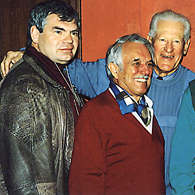
Jim Kellam bonds with two unidentified friends at recent AO Course.
During the past year, several important aspects of AO Education in North America have taken place. In June 1996, the Education Committee attended its second accreditation review with the ACCME Accreditation Committee. AO North America, through the Education Committee, has received a full accreditation to grant continuing medical education credits for the next 2 years. This ability to provide continuing medical education documentation to our courses has greatly facilitated the organization and documentation of the continuing medical education. However, this does not come without major responsibilities. These responsibilities have included upgrading our disclosure statements, assuring an unbiased presentation, guaranteeing that implants used for OFF labeled reasons are identified, as well as maintaining precise documentation of all events that occur. This has put a tremendous workload on the AO North American Continuing Education Department under Joan Rousseau. Without the CME departmentís work and support, these courses would be extremely difficult to even consider undertaking at this time.
The second major event that has occurred is the approval by the Education Committee of the AO-Foundation of the concept of the modular course design as proposed by the working group under Dr. Joseph Schatzker. This course is a principle-based course. It is meant to teach basic principles and then, once these have been understood, to build upon them to teach specific fracture management. This provides the ground work for the development of ongoing continued specialty courses. Once the surgeon has learned the basic principles, he is then able to branch out and understand the more advanced concepts of fracture surgery fixation. At the International Education Committee Meeting in June of 1996, the committee approved, in principle, the content and course design of the principle-based fracture course. This course will now be run over the next several years. In order for this course to be consistent, the basic principle segment of it will be defined. The working committee is in the process of establishing objectives for all lectures and laboratories. A syllabus for all of the lectures will be developed with the accompanying slides, which are necessary for the basic aspects of the course. A laboratory manual will be available for all instructors, so that they will be able to understand exactly what their role is and the objectives for each laboratory. This, under no circumstances, is to take away from the individuality of our AO instructors and faculty. What it is going to do, is to provide a basis upon which we then can work to further exemplify the principles through our own examples and cases.
In order for these courses to continue, it will be necessary to update our instructors. This will require a more formal introduction during a precourse meeting. In North America, this will probably be a two-hour or three-hour morning session, in which the laboratories will be demonstrated so that the instructors will become attuned to what is needed and how they may help the students better through these laboratories. The introduction of Distant Learning Material for both student and faculty is also under consideration at this time.
As some of you may well be aware, there has been a move, over the past several years, to also upgrade our teaching abilities. This has been brought about by the need for us to understand what Adult Education is all about. Using Mr. David Pitts, a professional educator, who is a consultant to AO-International and the UK AO Education Committee, AO North America has introduced some of the new education concepts. These will continue to be introduced, but through the precourse meetings, and will be done by our surgical colleagues working with other faculty to improve our teaching. The AO North America Education Committee has also instituted a peer review process of faculty evaluations at each course. Each day a faculty member is identified to review the lecture and laboratory performances of his colleagues. This, at present, is under trial basis to see what information is being gathered and evaluate if this can be of any assistance to our faculty. It is hoped that this will be done in the sense of the AO Family, as a supportive learning event, and not as a critical occurrence.
The Education Committee has also expanded its membership, and has not officially added a permanent position from Canada. The first Canadian to fill this position will be Dr. Rick Buckley, from Calgary.
One important aspect of CME accreditation is the response of the organization to the needs of the consumer (the surgeons). Dr. Eric Johnson identified a need in his area for education in the management of failed fracture fixation. During Nov. 9-11, 1996, Dr. Johnson and Keith May ran a successful course on Failed Fracture Fixation. This course was oversubscribed and will undoubtedly be repeated in future years. As evidence of its success was the comment by Dr. Rene Marti, a European faculty member, that it was the "best course he had been to." We look forward to another productive educational year in 1997.